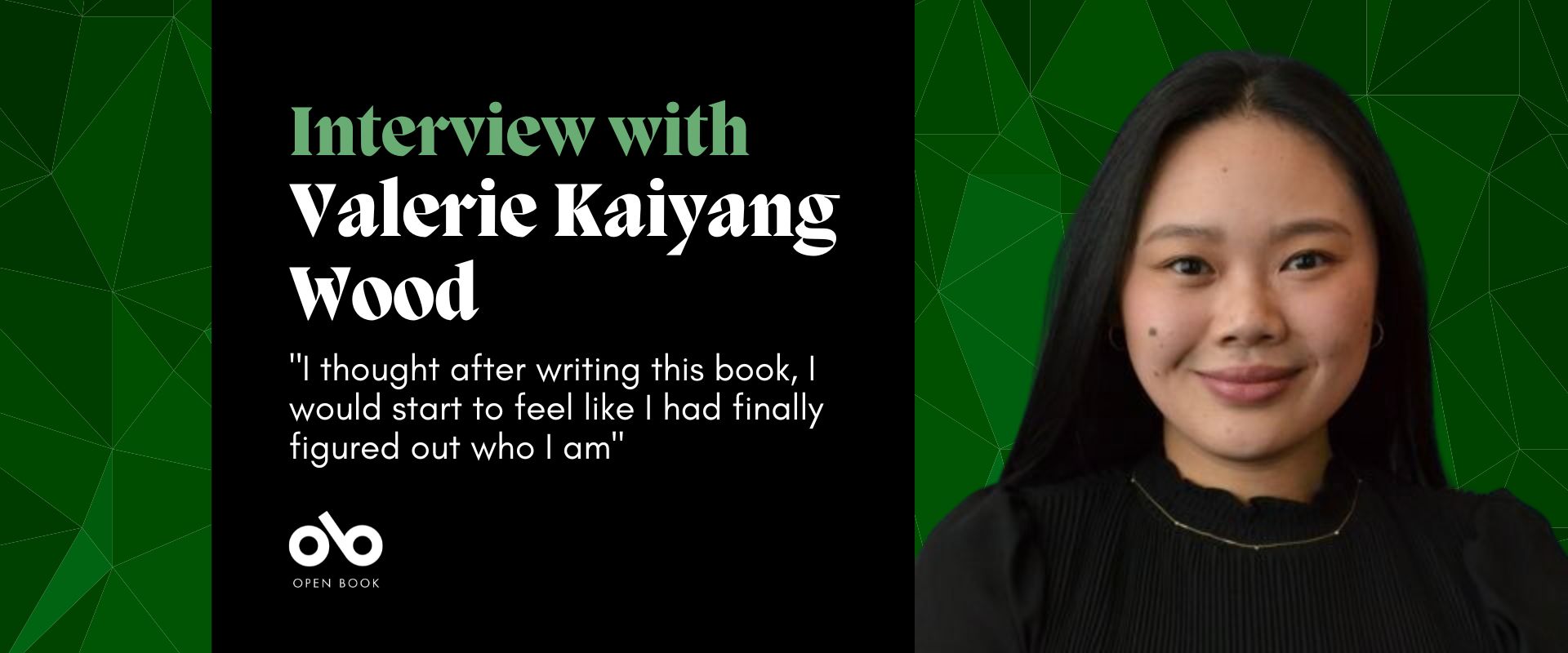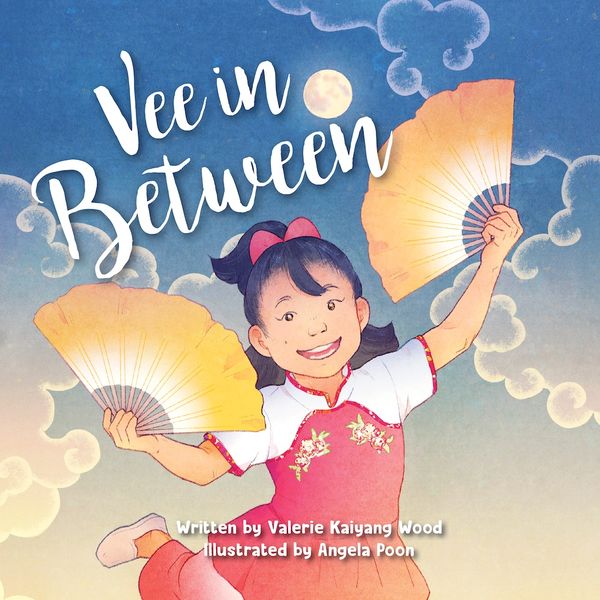Valerie Kaiyang Wood Explores Transracial Adoption in Her Dazzling Debut Picture Book
Transracial and transnational adoptions are complex processes, with parents welcoming children from cultures they don't necessarily have any connection to, and children arriving into families who may not have the tools to guide them through the process of navigating multiple identities. Adoptees can have vastly different experiences and different relationships with their cultures, both the ones they were born into and the ones into which they are adopted.
Valerie Kaiyang Wood was adopted from China by Canadian parents before her first birthday. As she grew up, she realized she wanted to tell stories like hers: ones that included love and nurture, but also struggles around belonging and identity. Her debut picture book, Vee in Between (Second Story Press, illustrated by Angela Poon) is the important and tender story of Vee, adopted at nine months – the same age as Valerie.
The book sees Vee's experiences, from difficulties in her Chinese dance class to encounters with people who make her feel like she's not welcome in either Chinese or Canadian communities. Vee wants to be what she is—a rich multitude—but the pressure to "choose" can feel unrelenting, and her white parents can't necessarily help.
When she connects with another adoptee, Vee is excited to explore her identity without the pressure to put herself in an oversimplified box.
Told with gentle thoughtfulness and clarity, Wood creates Vee as a memorable heroine and provides a necessary resource for adopted children, adoptive parents, and educators. We're excited to speak with her about her debut today, as she tells us about gorgeous details from the book, like when Vee asks questions of the moon, imagining it as a connection to her birth mother; how a certain characters "allowed [her] to imagine a conversation between [her] older and younger selves"; and about the Vee-related adaptation she's working on which allow her to go further in exploring Vee's experiences of food, language, and more.
Open Book:
Telll us about your new book and how it came to be.
Valerie Kaiyang Wood:
Vee in Between is a semi-autobiographical children’s picture book based on my experiences of transracial adoption. The book tells the story of Vee, a young Chinese girl who was adopted by a white Canadian couple, as she navigates her complex racial and cultural identities. Vee’s loving parents help her understand her past and racial identity as best they can, and for the questions they can’t answer, Vee finds comfort in talking to the Moon, which she imagines connects her to her Chinese birth mother. When Vee takes up Chinese dance, she feels alienated from her parents for the first time, and as she throws herself into learning this new activity, she becomes painfully aware of the precarious nature of being racialized in her white Canadian family and community. She is finally comforted by her dance teacher, an older Chinese adoptee who helps Vee understand herself as being somewhere “in between” all the overlapping identities she holds.
I started this book in 2019, as part of my Master’s in Public History at Carleton University. My graduate work looked at how children’s picture books can be used to tell diverse and difficult histories to children, and the first draft of Vee in Between formed the centrepiece of my project. After I graduated in 2021, I submitted the book to Second Story Press (SSP), and we have spent the last few years getting it ready for publication.
OB:
Is there a message you hope kids might take away from reading your book?
VKW:
Vee feels conflicted in her racial and cultural identities, but she eventually feels empowered by being “in between” all of her identities. I hope kids reading the book will come away also feeling empowered to exist in their own “in-betweens,” no matter what that looks like for them, but especially for other adoptees.
Your CanLit News
Subscribe to Open Book’s newsletter to get local book events, literary content, writing tips, and more in your inbox
I also think the beauty of books is that you can spend endless amounts of time planning what you want readers to take away from the book, but then it takes on a life of its own, and people relate to it in ways you could never expect! For example, a friend has told me that the concept of “in-betweenness” is something she wants to bring into her work as a social worker with bereaved families.
OB:
Did the book look the same in the end as you originally envisioned it when you started working, or did it change through the writing process?
VKW:
Overall, the story has stayed remarkably similar to what I originally envisioned. The main differences between the first version I wrote at Carleton University and the final published version with SSP were in word count and pacing. When I first started working on Vee in Between, it was over 1500 words, but only 23 pages. Once I started working with SSP, we managed to cut down on the word count, and changed the pacing of the book to stretch it to the typical picture book length of 32 pages.
One of the best pieces of advice I got from my editor, Jordan Ryder, was that in picture books you want to show emotion, rather than explain it. The first version was heavy on over-explaining how the characters felt, whereas in the final version, we let their emotions speak for themselves through their actions. This approach makes the book much more poignant. Plus, Angela Poon’s beautiful illustrations really show off the characters’ range of emotions.
OB:
Is there a character in your book that you relate to? If so, in what ways are you similar to your character and in what ways are you different?
VKW:
Perhaps this is too obvious, but since the book is semi-autobiographical, I relate to the character of Vee and see her as a young version of myself. However, I also relate to Vee’s dance teacher, Kaiyang. Kaiyang is my Chinese name, given to me by the orphanage when I was a baby. Sharing this name with the dance teacher was a way of connecting me to the character and allowed me to imagine a conversation between my older and younger selves. Whether or not readers pick up on the connection between myself and Kaiyang, I felt it was important for Vee to learn from an older adoptee, because it reflects the importance that community plays for Chinese adoptees. As I was part of the earliest cohort of Chinese adoptees to Canada, I never had anyone older to look up to, so Kaiyang is not only who I am, but she is also who I wish I’d had growing up.
I’ve thought about this a lot, and even though I really relate to both Vee and Kaiyang, I feel Vee is who I am, and Kaiyang is who I am still aspiring to be. Vee is still figuring out who she is, and how she fits into her community, whereas Kaiyang (at least in Vee’s eyes) has it all figured out. I thought after writing this book, I would start to feel like I had finally figured out who I am, and how to make sense of my identity as a Chinese Canadian adoptee, but I haven’t. I’m still unsure, however this book has given me the chance to connect with so many others who feel similarly, and that in itself is very comforting.
OB:
What do you need in order to write – in terms of space, food, rituals, writing instruments?
VKW:
In terms of writing instruments, I always like to start with pen and paper, jotting down ideas, and major plot points. I then quickly turn to writing on my laptop, as I can type faster than I can handwrite, and I want to get all my ideas down as quickly as possible! (And be able to delete the bad ones just as quickly!)
For space and food... I don’t think I’m too picky. I love a fun drink, like bubbly water, a latte, or fruit juice – and sometimes all three at the same time! Since I wrote most of Vee in Between during the Covid lockdowns, I didn’t have much choice in writing locations, and wrote most of it from the couch. For the next book, I suspect I’ll oscillate between writing on the couch and at cafés. Cafés have coffee and treats, but my couch has my two black cats!
I don’t think I have any rituals...Unless you count asking my partner what he thinks of basically any idea I have!
OB:
What are you working on now?
VKW:
I am in the early stages of adapting Vee in Between into a middle grade book. Early on, I chose Chinese dance as the activity that would connect Vee to her Chinese heritage, however there were many other cultural touchstones I could have chosen. This includes food, language, and cultural celebrations. It is my hope that a middle grade version of Vee in Between will allow me more space to deeply explore the many ways in which Chinese adoptees engage with their race, culture, and heritage.
________________________________________
Valerie Kaiyang Wood was born in China and adopted to Canada at the age of nine months. Drawn to the storytelling power of history, she completed her MA in Public History and Curatorial Studies at Carleton University where she began writing her children’s book based on her experiences of transracial adoption. Valerie is passionate about centring diverse perspectives in both her writing and her work as a museum curator in Ottawa.





